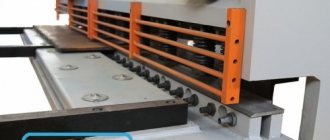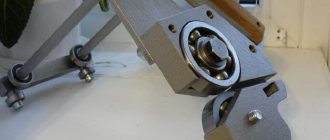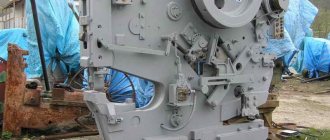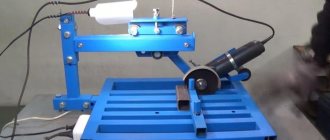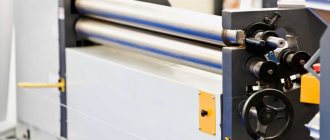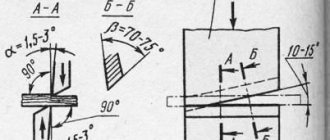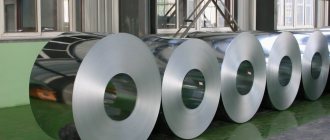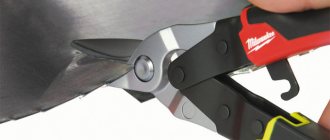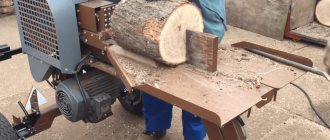Cutting metal with scissors
TO
category:
Metal cutting
Cutting metal with scissors
Next: Cutting metals with powered hacksaws
Scissors are used for both manual and machine cutting of metals. The sharpening angle p of scissors ranges from 65 to 85° depending on the hardness of the metal being cut: for soft metals (copper, etc.) it is 65°, for medium-hard metals 70-75°, for hard metals 80-85°. To reduce the friction of the scissors knives when working on the blades, a rear angle a equal to 1.5-3° is created. The scissor knives are made of U7 carbon steel; their cutting part is hardened.
Cutting with hand scissors. Manual metal shears are shown in Fig. 1. The most common sizes of scissors are 250-320 mm (according to the total length of the scissors).
Hand scissors are divided into right and left. For right scissors, the bevel on the cutting part of each half is on the right side, and for left scissors, it is on the left side. When cutting a sheet with right-handed scissors, a mark is always visible on the metal being cut. When working with left-handed scissors, in order to see the mark, you have to bend the cut metal with your left hand, passing it over your right hand, which is very inconvenient. Therefore, cutting sheet metal in a straight line and along a curve (circles and curves) without sharp turns is done with right-handed scissors.
Rice. 1. Right (upper) and left (lower)! hand scissors and use of right scissors
With hand scissors you can cut sheet steel up to 0.7 mm thick, roofing iron up to 1 mm thick, copper and brass sheets up to 1.5 mm thick.
When cutting metal, the scissors are not opened completely, but only enough so that they can grab the sheet. When fully opened, the scissors do not cut, but push out the sheet. When cutting round discs with scissors, the latter are turned counterclockwise, and the scissors should not cover the cut lines.
Rice. 2. Chair scissors
Cutting with chair scissors. These scissors have one of the halves with a handle with a pointed end bent downwards; With this end, the scissors are secured in a wooden beam. The second half - with a straight handle - is used for hand work.
Rice. 3. Manual lever scissors: a - with overkill: 1 - lever, 2 - overkill, 3 - upper knife, 4 - lower knife, 5 - stop; b - flywheels: 1 - lever, 2 - upper knife, 3 - pressure bar, 4 - table, 5 - lower knife, 6 - stop
Chair scissors are stable when cutting and give greater freedom to the hands of the worker. They cut sheets 2-3 mm thick.
Cutting with lever scissors. In Fig. Figure 3 shows lever hand scissors with pick-up, designed for cutting sheet metal, thin rods and profile material, and lever hand shears, used for straight cuts of sheet metal up to 2 mm thick (for steel) into strips. There is one knife installed on the table of the swing shears, and a second one on the lever itself. A balancing weight is placed at the end of the lever.
Sheet metal is cut using fly shears by one person. The sheet is laid on the table so that the cutting line (when cutting with markings) coincides with the blade of the lower knife. Having pressed the sheet with the upper bar, the lever with the upper knife is lowered with a strong movement. Then the lever is “pressed” until the required part of the sheet is cut off.
When cutting without markings, the width of the strips is adjusted using a movable guide ruler.
Cutting with parallel scissors. These shears, sometimes called guillotine shears, are used for cutting sheet metal with a thickness (for steel) of up to 4 mm or more. In the parallel guides of the scissors, a slider with an upper knife mounted obliquely on it moves up and down; the lower knife is fixedly fixed in the frame. Raising and lowering the top
Rice. 4. Parallel (guillotine) shears: 1 - drive, 2 - flywheel, 3 - clamp, 4 - upper knife, 5 - table, 6 - sheet to be cut, 7 - inclined bridge - lining for cutting the edge of the sheet at an angle, 8 - pedal for starting shears
The cutting of the knife is carried out by a crank mechanism, receiving movement from the working shaft, which is driven into rotation by an electric motor through a transmission from the drive pulley.
Cutting with disc (round) scissors. In Fig. Figure 5 shows disk (round) shears used for cutting sheet metal with an unlimited cutting length, as well as for curved cutting. The cutting tools are disc knives located one above the other and rotating in different directions when working. To cut straight strips, the disc knives are placed parallel; to cut curved shapes (circles, holes), the knives and their axes are positioned at an angle to each other. There is no need to feed the sheet into disks; the disks, rotating, tighten the sheet themselves,
Rice. 5. Disc (round) scissors and work on them: a - cutting a sheet into strips, b - cutting out circles, c - arrangement of knives for cutting a sheet with a curved outline of parts
What are metal scissors?
This device is designed to cut metal sheets and reinforcement. When compared with similar methods of working with metal, this cutting option has several obvious advantages:
- Cheapness. Mainly for the reason that you don’t have to spend extra money on consumables (cutting wheels and gas).
- The properties of the metal after cutting remain the same. Since the blades of the scissors do not heat up, and therefore do not in any way affect the structure of the metal sheet.
- Cutting time is much less.
- Ease of use. Cutting with such a simple tool does not require any special knowledge or skills from you.
- The tool does not require maintenance or special care.
- The scissors are very compact and portable.
Brief overview of brands
The author does not intend to advertise specific samples of metal scissors. The point is different. Any competent specialist associated with the field of sales will confirm that we mostly choose something “with our eyes.” And this is precisely the main reason for further disappointments, complaints that what was acquired is not exactly what we would like. Therefore, it makes sense to arm the reader with preliminary information about those models that are most often present on the windows (counters) of retail outlets.
"Kraftool"
For cutting metal up to 1.5 mm - a good choice. These scissors can be used to work with sheet metal, angles or other profiles. With certain skills, it is not difficult to make a figured neckline. It is products under this brand that are in greatest demand.
Price – from 850 to 1,050 rubles.
"Bison"
No less popular domestic products. Made from tool steel, these scissors allow you to cut in any direction. Depth – up to 1 mm, which is quite sufficient for domestic use in most cases.
Price – within 210 rubles.
"Sparta"
Products are from the “made in China” series, and this is the main reason why many people treat them with some suspicion. But in vain. All production is organized using German technology, using appropriate equipment, so these scissors have proven themselves quite well when working with thin (up to 1 mm) metal. By the way, those who have already dealt with them prefer to purchase them instead of more expensive foreign analogues.
Price – about 245 rubles.
The listed scissors are suitable for any household work with metal. They will allow the home craftsman to perform a variety of technological operations.
The cost of hand-held metal shears in the “household tools” category ranges from 65 to 1,050 rubles. If you have to cut metal quite often, it is advisable to have at least a couple of models on hand. This will not have much effect on your wallet, but in most cases there will be no problems. After all, even with minor repairs you have to cut either a metal profile or a sheet.
For what purposes are metal scissors used?
- In the automotive industry. This includes the creation of flat rectangular blanks and shaped elements with turned sides and made holes.
- In construction. Creating parts for the roof and cutting metal elements to prepare the base of the building.
- At metal yards for cutting rolled metal to meet the various needs of residents.
- In the work of rescuers. Such scissors are quite often used for sorting out all kinds of rubble due to collapse due to bad weather.
- When dismantling various equipment and scrap metal.
- At home. The use of scissors greatly helps owners in minor repairs of metal structures and more.
Straight Cut Scissors
When cutting this way, you need to “squeeze” the scissors between the halves of the sheet of metal. The design is suited for this quite well due to the wide lower blade, which prevents the left half of the sheet from bending down, and the recess under the hinge, through which the left side of the sheet being cut passes.
Scissors for straight through cutting can be produced in two variations: left and right. This is due to the fact that the cut of the material is not symmetrical and there are times when the use of right-cut scissors is preferable. Most straight cut models come in a left-handed specification, making them more suitable for right-handers.
A slightly different design version of the scissors needed for straight through (left) cutting with a multi-lever hinge.
Electric scissors for fast and precise cutting of sheet material
Evenness and aesthetics of cutting with mechanical scissors is achieved only with the proper purchase of the tool. In addition to mechanical ones, manufacturers also make electric shears.
Such a tool does not need your power to cut the material, since the electric motor is now responsible for this.
Electric scissors come in the following types:
- Die-cutting or die-cutting - their design is fundamentally different from manual ones.
- Knife scissors are similar to mechanical scissors, and only 1 blade is responsible for their work.
Die-cut
They acquired this name because of their operating principle. They are used for cutting corrugated sheets and metal tiles when installing roofing. Their main advantage is their ease of use and operational efficiency.
When cutting sheets of steel or other alloys, no sparks are generated, plus the material does not wrinkle along the cut boundary.
- With these scissors you can cut sheets either in a straight line or create different patterns.
- If you intend to create a certain shape in the middle of the sheet, then the first step is to drill a hole and then start cutting from the middle.
When piercing steel in this way, the blade moves very quickly, so the sheet simply does not have time to deform.
Knife
They are very similar to conventional mechanical tools, only they are made of movable and fixed blades.
- The working blade moves thanks to an electric motor, performing cyclic reciprocating actions.
- These scissors are suitable for straight or curved cutting.
If the sheet is thin, then the edges may wrinkle in some cases, sometimes this is due to the fact that the metal is simply soft in itself. To prevent this from happening, knives should be sharpened periodically.
Why do you need guillotine shears?
There is another type of scissors, which also belongs to the group of hand tools. They're called
guillotine, which consist of a frame, as well as a fixed knife and a movable blade. Due to their design, they are also called tabletop or stationary. To cut sheet material, it is necessary to place the sheet on the knife according to preliminary markings. The sheet is cut by lowering the cutting blade.
This type of tool is suitable exclusively for cutting in a straight direction. They are not suitable for circular cutting, so you should choose a tool depending on its purpose. Guillotine shears are used in industry when large volumes of work are performed. Manufacturers also produce hydraulic guillotine tools for cutting pipes, profiles and other compact non-sheet materials.
Main selection criteria
Execution option. Scissors are produced in right and left versions, which depend on where the lower knife is located.
Usually the tool is created with the lower blade on the left, so the tool is very convenient for right-handed people, but for left-handed people the reverse position of the blade is more in demand.
Material thickness
Always carefully read the manufacturer's notes, as he always indicates the permissible thickness of sheet metal that the tool can work with. If you do not take this point into account, then at best the handle will simply break; at worst, a splinter of the blade will injure you when cutting.
Blades
Chrome vanadium steel is the most popular material in the manufacture of metal scissors. Stainless steel knives are more valuable on the tool market, but, as a rule, such scissors are much more expensive.
Handles
The secure grip of the handle ensures comfortable and long-lasting work without chafing. A good handle should be made of durable plastic that can withstand enormous loads. It is important that the handles contain fragments of rubberized material, this way the handles will protect your hands from injury when slipping.
Length
Typically, the length of the handles varies from 17 to 37 centimeters; you need to choose depending on the regularity of work and the thickness of the metal.
Select the tool at your discretion; it is important to take into account the fact that the longer the handles, the less force you need to apply to make the cut.
Best Shears for Sheet Metal Cutting
Products in this rating category are designed for cutting or trimming sheets of aluminum, galvanized steel or copper plates. Most often, this tool is used by tinsmiths or drywall workers. It is also actively used in the production of ventilation systems and drains.
Hazet 1961R-1
Rating: 4.9
The first place in our rating is occupied by a product from the German brand Hazet. The scissors are made of two metals, where the cutting part is made of high-carbon steel, and the drive is made of a stainless alloy. This design reliably protects the material from corrosion and extends its service life. The product is suitable for making straight and curved cuts. To prevent the hand from slipping off, high stops are provided. To prevent pinching of fingers, there is a stop on the drive.
Our experts rated the product as the best in several areas at once. Due to the thick jaws, the tool is capable of cutting through a section of ordinary metal up to 1.8 mm. It will also be possible to cut out reinforced sheet metal up to 1.2 mm thick. In addition to the power, users in the reviews like the ease of holding due to the thick handles. They evenly distribute the load when pressed. Another advantage of the product is high build quality and long service life. If handled correctly, they will withstand up to 10 years of active use.
Advantages
- compact length 26 cm;
- comfortable grip;
- serve up to 10 years;
- cuts through metal up to 1.8 mm.
Flaws
- there is no lock in the closed position (they can open on the belt and injure the body);
- high price;
- the coating of the handles is not dielectric;
- This model needs to be held in the left hand, which is inconvenient for right-handed people.
Rules for cutting with scissors
When cutting sheet metal, it is important to consider the following operating rules and safety regulations:
- It is possible to cut metal sheets of small thickness without any additional design solutions. To do this, you need to lay the metal on a workbench, fix one end with your hand, and cut the other according to the markings.
- When cutting metal of considerable thickness, you should clamp one handle in a vice, in this case there will be a reliable stop. The pressure on the knives increases, and therefore you will be able to cut large sheets.
- If you are cutting wire with metal scissors, you must use gloves made of thick material.
- In order to protect your eyes from mechanical damage, it is important to wear at least glasses, but it is better to use a face mask.
- Fix the separated pieces of wire when cutting towards the workbench.
- You can give a piece of wire or sheet to other people only with the sharp ends facing you; this is done in order to protect the other person from accidental cuts.
We hope that you have carefully read our article, which means you can choose good metal scissors without any problems. All the best!
Product Catalog
Home >> Information >> Articles >> Metal shearsMetal shears are a tool that is used for cutting sheet metal or thick wire.
Metal scissors are divided into several types. Most often, metal scissors are divided according to the cutting principle: knife and nibbler, and according to the operating principle - manual and electric.
Nibblers operate on the principle of hollowing out metal and are used to cut profile metal (corrugated or welded sheet of several elements), pipes, and ventilation boxes. The peculiarity of nibblers is that they allow you to start cutting metal from the middle of the sheet.
Knife scissors are more “classic” scissors. They cut with two single-edged knives. It is impossible to cut metal from the middle with knife scissors; cutting can only be done from the edge of the sheet.
Manual scissors, respectively, are designed to work with your hands, while electric scissors work from the mains or from a battery. It must be taken into account that there are no hand-held nibblers.
Types of knife scissors.
The design of metal shears is based on the following principle. Almost all knife scissors have two knives, fixed at a certain angle from 7 to 12 degrees. The shape of the knives and the angle at which they are located differ and depend on the type and purpose of certain metal scissors.
Metal shears allow you to cut sheet metal into elements of different shapes and sizes, and allow you to cut out shaped elements. Depending on the design and purpose, metal shears are divided into several types.
Firstly, metal shears are divided into right- and left-cut scissors. Right-handed scissors have a marking line to the right of the cutting edge; left-handed scissors, on the contrary, have a marking line to the left of the cutting edge.
Typically, metal is cut according to pre-applied markings and metal cutting scissors are always positioned in such a way that the upper blade is above the marking line.
Secondly, metal shears are divided into types depending on their purpose. Some types of metal scissors are suitable for cutting metal into even pieces in a straight line, while other types of scissors are used for cutting out shaped pieces or for making holes in a sheet.
Straight-cut shears, or “through” shears, cut metal in a straight line.
Curvilinear cutting scissors (curly) allow you to cut shapes of different shapes and sizes. The small cutting head gives the scissors greater maneuverability. This is what allows them to cut out different shapes.
Curvilinear cutting scissors also include radius metal scissors. The blades of radius scissors are curved, which allows these scissors to cut shapes with smooth, rounded edges and small diameter holes. In addition, radius shears can be used to punch holes in a sheet of metal.
Universal or combined metal scissors. Such scissors are called universal because they can be used for both curved and straight cutting. That is why they are very popular.
Roofing shears, also known as chair shears, allow you to cut thicker metal (2-3 millimeters). To make work easier, roofing shears can be attached to a workbench, which makes it possible to work on metal with less physical effort.
Lever metal shears are also used for cutting thick metal or hard metal, since the lever mechanism built into this tool significantly reduces the effort that must be applied when cutting metal. The peculiarity of lever scissors is that they can only be used when attached to a workbench.
Types of electric scissors.
Electric shears are used for straight and shaped cutting of thicker metal that is difficult to cut by hand. In addition, electric shears are used when high precision cutting is required and in cases where it is necessary to cut metal in a place that is difficult to get to.
Electric scissors are quite reliable and can work for quite a long time.
Electric scissors are divided into types depending on the power source and operating principle.
Based on the power source, electric scissors are divided into mains and battery-powered. Battery-powered ones are often used in places where there is no power grid. However, if you plan to work where there is an electrical network, it is better to take network ones, since rechargeable ones weigh more due to the presence of a battery.
In addition, electric scissors are divided into knife and cutting ones.
Electric knife scissors are similar to manual scissors. They consist of a pair of single-edged blades, one movable, one fixed. The movable blade is driven by an electric motor. A sheet of metal is placed between two blades and cutting is carried out. Electric knife scissors most often have a built-in mechanism that allows you to adjust the distance between the knives.
Electric knife scissors can only be used to cut starting from the edge of the sheet. It is impossible to start cutting from the middle of the sheet due to their design. In addition, it is difficult to carry out figure cutting with electric knife scissors.
Electric nibblers have a structure with a diameter of 57 millimeters and a motor that powers the scissors. The head of the cutting shears resembles a chisel, and the principle of operation is to knock out the metal located between the movable and stationary parts of the scissors with this head. Most types of electric nibblers are equipped with a mechanism that pushes the metal downwards. This provides visibility when working, which, in turn, improves its quality.
With electric cutting shears, you can start working from the middle of the sheet, but to do this you first have to make a hole in the sheet of metal using a drill.
Electric cutting shears are divided into several types.
One of the most popular and favorite types of scissors by craftsmen are slotted scissors. They are loved for their versatility. With slotted scissors you can cut sheet material, cut holes in sheets and pipes, and make curved cuts.
Slotted shears have an open cutting head so you can monitor how you cut. This simplifies the work and makes the cut more precise.
Slotted shears are used in metalworking, the manufacture of ventilation systems, for cutting sheet metal, in plumbing and tin work.
| Next |
Photos of the best models of metal scissors
Tool structure
The design resembles an angle grinder in appearance. The body is made of ABS plastic. An engine is installed inside it. The front part is equipped with a multi-stage gearbox, which is protected by a metal casing. Its function is to convert the rotational motion of the spindle into reciprocating motion. Thanks to this, the equipment comes into action.
The working unit consists of a static element and moving parts. When metal is passed between them, its structure is destroyed along the cut line.
The design of electric scissors also includes:
- protective plate-shield;
- handle;
- electrical cable.
What materials are electric scissors designed for?
Electric types of tools are most often used for the following materials:
- metallic profile;
- sheet metal;
- plastic;
- various types of roofing material;
- fittings of various diameters.
Such equipment can be used for cutting other metal elements. A distinctive feature of electrical devices is their motor, which provides enough power to cut objects of various thicknesses.
Tool selection rules
When choosing, you must first focus on its purpose. It is worth noting that prices for products also differ quite a lot. If, for example, the cost of manual devices ranges from fifty to two thousand rubles, then the price of hydraulic ones can reach twenty thousand rubles.
In any case, when choosing, you need to pay attention to:
- location of knives;
- their shape;
- cutting capabilities of the product;
- power;
- ergonomics;
- availability of protection;
- maneuverability.
If scissors are needed for one-time use, you can get by with a hand tool. If it is necessary to process a large number of materials, you should pay attention to more powerful mechanical products.
Thus, today there is a wide variety of scissors on the market designed for cutting metal. They differ in design and purpose. There are both mechanical and manual products. In order to choose the right tool, it is recommended to follow the tips above.
Punching devices
Like the previous type of tools, they belong to mechanical products. Their action is based on the vibrational reciprocating movement of the upper knife. It is driven by a rapidly rotating eccentric mounted on a shaft from an electric motor.
Such devices for cutting sheet metal make it possible to start the procedure both from the edges and from the center. There are no sparks during operation, which protects the material from damage. Therefore, nibblers can be used to cut profiled metal. To cut in the center, you must first make a hole in the sheet, into which you then insert the cutting edge.
The permissible thickness of the material is no more than 2.7 millimeters. Within one minute, a cut of three to six meters in length can be made. The tool is convenient, compact and productive. Therefore, it is very popular among professional craftsmen.
How the tool works
Scissors used to cut metals work by plastic deformation. After using them, there are no chips left, that is, waste. The basis of the tool is a pair of knives. When they close, they exert pressure on the workpiece, thereby separating it.
In this case, the line along which the cutting was made is smooth.
The gap between pairs of knives plays an important role in the operation of scissors. If its size is insufficient, the edges of the cut will be “torn”. Too large a gap can lead to the appearance of burrs. When choosing this parameter, you must focus on the thickness of the material being processed.
The sharpening angle of the blades also matters. For the cutting side of the scissors, this parameter is seventy degrees. This angle helps prevent chipping of the blade in the event of intensive use of the scissors. The relief angle in most cases ranges from one to two degrees, which reduces friction during cutting.
Lever and roofing products
The hinged connection between the handle and the cutting edge is the main difference between lever tools and hand tools. Thanks to it, an additional lever is created, which facilitates the work of the master. This type of product has the following advantages:
- requires less effort;
- provides high cutting quality.
However, such scissors have a significant drawback - they must be attached to a workbench. Without it, it is impossible to work with the tool.
Materials with a thickness of two to four millimeters can be cut using roofing tools. Their design features make it possible to attach products to a workbench. This reduces the effort required to separate metal sheets. Best suited for products with complex shapes and profiled sheets.
Types of mechanical shears
Manual metal scissors are used for cutting sheet material and tin. The maximum thickness of sheets for steel is 1.0 mm, for aluminum - 2.5 mm. Different jobs require the use of tools with different characteristics. According to operating parameters, they are distinguished:
- Bench shears for straight cutting. Can only be used for straight or large diameter circular cutting.
- Curved scissors. They have rounded blades that are convenient for cutting out shaped elements or holes.
- The finger instrument has very thin blades. Used to make complex shapes.
- Chairs. It is possible to secure the lower part to a workbench and apply force only to the upper handle. This increases the potential force on the blades.
- Power scissors. Equipped with a double lever transmission mechanism. Can cut sheets up to 2.5 mm thick.
- Lever model. It is mounted on a workbench and has only one movable blade.
Depending on the arrangement of the blades, there are left-handed and right-handed tools.
The left ones are designed to make a cut rounded to the left side, and their cutting lower edge is located on the left. They should be held in the right hand. The right ones have the cutting edge on the right and the ability to make a cut rounded to the right.
Cutting tools also differ in the manufacturing method. Products are produced by casting or forging. Forged products are more expensive, but they will last longer than cast ones and do not require frequent sharpening. To sharpen the scissors well, you will need a horizontal grinder or emery machine with an abrasive wheel for sharpening the cutters. You can sharpen scissors correctly in a tool shop, or it is better to take them to a specialized workshop.
The quality of the cut without burrs or burrs also speaks in favor of more expensive products. Cutting capabilities is a parameter that shows the permissible thickness of the processed steel sheet.
Guillotine and lever models
Lever shears are designed for cutting thick sheets and metal rods. The design feature is the rigid fastening of the lower knife to the frame. The upper knife remains movable and is fixed to the lever. The lever greatly increases the force applied to the cutting edges. When the lever is lowered, the material is cut. Lever mechanisms are used only for straight cuts. If it is necessary to cut out shaped parts, use hand cutting or an electric tool.
If it is necessary to cut thick metal, guillotine machines are used. The principle of their operation is similar to lever devices, but the drive is not manual, but electric or hydraulic.
The cutting blades are also chosen to be more powerful. This allows cutting materials with a thickness of more than 5 millimeters.
The best manufacturers
To choose hand shears for metal, it is useful to focus on tools from well-known brands. Among the many manufacturers of hand tools are:
- Kraftool. It has proven itself well in the market of household and professional tools.
- SMI LLC Arefino. Russian manufacturer. It produces reliable and easy-to-use products.
- Gross. Manufactures hand-held professional metal scissors from high-quality steel.
Products from well-known brands are expensive, but cheap products may be of poor quality and will not last long.
Roller and hydraulic shears
Another type of mechanical device for cutting metal is roller products. In most cases, their design consists of rollers (sharpened) or disk knives, which rotate in different directions using an electric motor.
Roller shears
During the cutting process, the metal is pulled between the knives and separated. Due to the mutual friction of the disks with the metal, the sheet moves along the product. The rollers can be located:
- parallel to each other;
- one roller can be inclined;
- both rollers are inclined.
Hydraulic shears are used for cutting rods, profiled iron, scrap, fittings and other metal structures. The force is distributed not on one blade, but on both knives (evenly). Hydraulic shears can be divided into two groups:
- large-sized;
- small-sized.
Small-sized (or hand-held) scissors can be used to cut products up to two centimeters thick. Large tools must be installed on a special machine.
